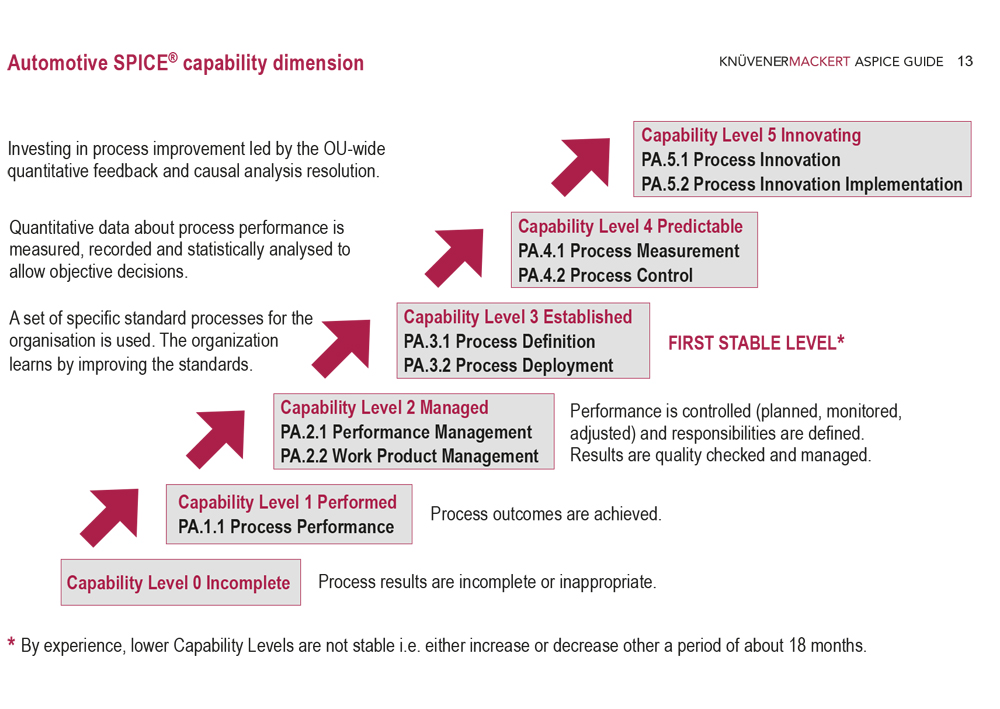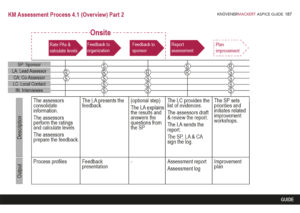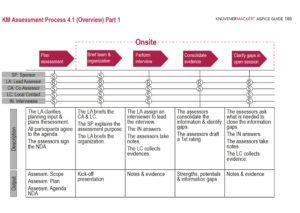Introduction to Automotive SPICE® Assessments
Product development in the automotive industry relies more and more on competence in Automotive SPICE® as a prerequisite. The intelligent implementation of the individual processes results in a significantly higher product quality and a trouble-free SOP.
A systematic consideration, implementation and checking of customer requirements as well as those of production planning and other interest groups is only one of the benefits that Automotive SPICE® offers.
In an ASPICE® Assessment, development capabilities are evaluated using interviews and document reviews. The results are documented and compared to the expectations given by the Automotive SPICE® model to assign a process maturity scoring.
Basic information about the assessment is provided below, together with tips describing how your organization can achieve good assessment results.
Reasons for the assessment
Prerequisite for the supply contract
Increasingly often contracts for projects are awarded based on the company’s proven ability to learn from mistakes. As proof an ASPICE® CL3 evaluation is demanded as evidence. This assessment report should come from a well-respected competent or principal assessor. The customer wishes to reduce the risk unexpected additional costs after awarding the project. CL3 is regarded as the first stable competence level, as this level certifies well-established processes.
Process Improvement
Assessments are often performed as a gap analysis for internal use. The independent evaluation provided by the assessment will point out the process gaps in the project. This provides a sharp focus for effective and useful process improvement.
Assessment Result
End-of-Assessment Presentation
In the KM Assessment process described below, the assessment results are presented to all participants at the end of the on-site phase. This is where the strengths and potentials of the processes are presented.
This presentation makes it clear how effective newly introduced or long-established processes are, showing where there is room for improvement.
Assessment Report
The assessment report together with the presentation serves as a basis for process improvement.
This report provides the management with a profile of strengths and weaknesses. Focused workshops can follow to derive suitable concepts and measures to make the processes more effective and, if necessary, more efficient. The highly experienced Knüvener Mackert consultant team will provide you with intensive support in enabling processes.
Depending on the intention of the assessment sponsor, the report can be presented to the client. It provides detailed information of development process performance based on the individual process attributes.

Standardization and Comparability of the Assessment
The result of the assessment should be independent of the assessor and his team. The following standards lay down the definitions of binding procedures with the intent of ensuring the necessary reproducibility.
ISO 15504 defines criteria for SPICE (Software Process Improvement and Capability Determination) This standard was revised in the standards ISO 330xx (in particular ISO 33002).
In Automotive SPICE® V3.1, criteria for objective measurability, which are specified in ISO 33020, were implemented. The competence levels CL1 to CL5 are described in detail. The base practices and general practices reflect the requirements that processes must fulfill for certification of the respective competence level.
Qualification of Assessors
The assessment may only be carried out by a certified lead assessor (Competent or Principal Assessor). Certified Provisional Assessors are admitted as co-assessors.
Intacs e.V. (www.infacs.info) ensures the quality of the examiner’s training through uniform syllabi, training materials and teacher certifications. The VDA’s Quality Management Centre accredits the training providers and conducts the assessors’ examinations independently of the training providers.
Performance of the assessment
In ISO 33002 the procedure, the roles of the assessment participants and the results of the assessment are specified in detail. This ensures that the assessment of projects from different suppliers and assessment teams can be compared. The lead assessor is responsible for carrying out the assessment. ASPICE® V3.1 defines that the lead assessor must be certified as a “Competent Assessor” or higher with an identity card at intacs™ Certification as a “Provisional Assessor” is required for at least one further assessor.
ISO 33002 also defines what must be included in the test report. Evidence for the process attributes and competence levels must be documented so that the decision-making process can also be understood by third parties.
Intacs™ Code of Conduct
Assessors who identify themselves through a VDA-QMC card commit themselves to the Intacs™ Code of Conduct.
VDA Guidelines (Blue Gold Edition)
In the VDA Automotive SPICE® Guidelines, the Association of the German Automotive Industry provides details for the interpretation, minimum content-related requirements and consistent evaluation of Automotive SPICE® elements. Defined rules and recommendations on detailed base practices (BPs) and generic practices (GPs) should lead to uniform test results.

Introduction: KM Assessment Process 4.1
The process of an assessment carried out by Knüvener Mackert is described in “KM Assessment Process 4.1”.
Planning Phase
In the planning phase, the objectives of the assessment are determined in consulation with the client (sponsor) : Should the focus be on process improvement or risk assessment of the product?
The boundary conditions are clarified: how is legacy code handled? Are there different locations, sub-project teams or components of suppliers?
Based on this information, the procedure, roles, locations of the assessment etc. are then discussed and agreed upon.
Together with the local coordinator, process owners are named, the interview plan is drawn up and the premises reserved.
Performing an Assessment
After the kick-off meeting, the process owners can demonstrate the competence of their processes by providing objective evidence in interviews. The team of auditors documents and evaluates the results and evaluates the processes according to their basic practices and generic practices. If necessary, open points are clarified in a general follow-up interview on the last day on site.
The focus here is on process execution, assigning blame for gaps is not a goal.
The final presentation at the end of the on-site phase provides fast feedback about the results of the evaluation. Knüvener Mackert places great value on clear description of the performance shown and identifying potential for improvement.
Reporting
In the weeks following the interviews, the results are systematically documented in the assessment report, checked by the lead assessor and handed over to the sponsor. The results of the assessment are not forwarded to VDA, intacs or any other institution, they are provided exclusively to the sponsor.
The assessment log serves the assessors as proof of their assessment experience and is submitted to the VDA for (re-) certification as Competent or Principal Assessor.
Proven Methods from Years of Experience
Preparation
- Our motto “Accepted processes follow simple rules” comes from many years of experience in consulting. The individual processes must be designed in such a way that they are effective for the project. Efficient processes eliminate unnecessary activities and concentrate on structured and unbureaucratic action.
- In order to arrive at such processes, systematic training of the personnel is required. Inform yourself in our Training Center [link] about our offerings. Examples from everyday life can be discussed in the in-house trainings. This facilitates direct implementation of the acquired competence.
- Employees are often trained as Provisional Assessors. On the one hand, they can gain a deep insight as co-assessors. On the other hand, this knowledge is extremely valuable in the daily work of process definition and improvement, because the employee understands why individual practices are examined in Automotive SPICE® and what potential value is derived from well defined processes,
In a pre-assessment, the gaps in the project can be worked out, which are then worked through in process improvement workshops. Read more about our consulting services.
The assessment itself
- Good arrangements in advance with the sponsor and local coordinator are the basis for an effective assessment. All necessary data for the assessment plan will be collected. The assessment agenda is worked out so that each process owner knows when the interview for the respective process will take place.
- Facilities and Catering: The process managers should be able to explain the performance of the process well and fluently. The atmosphere during the interviews is very important for this. Drinks and snacks in between help to maintain concentration.
- Technology, documents and tools should be available in adequate speed in the infrastructure of the premise. The better the process “configuration management” works, the less time is devoted to the search for relevant documents .

Alexander Mackert
Principal Consultant & CEO
ASPICE® Assessment Quotation
Our team has a lot of international experience and has offices in Germany, India and China. Get in touch with us and request a quote for an Automotive SPICE® Assessment.
We are also happy to accompany you on your journey to the targeted competence level through pre-assessment and improvement workshops .




